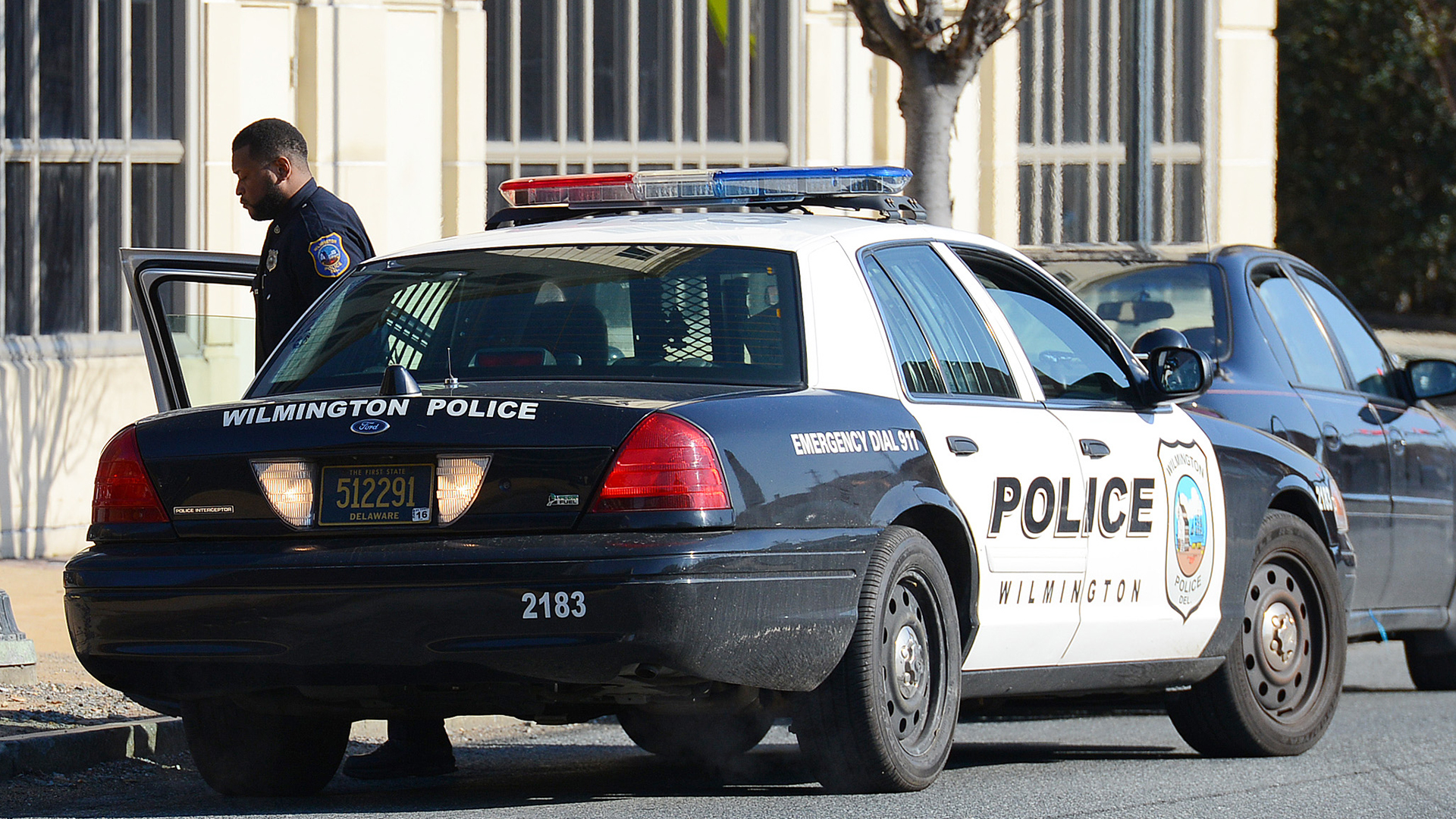The Endless Cycle

Devastating crime stats in Delaware’s largest city have made national headlines, and things are getting worse. That’s why city officials would be wise to consider the research findings of a WilmU doctoral candidate — who also happens to be a former cop.

Wilmington, Delaware’s largest city, has been continually scrutinized in the media for its rising rates of crime and violence and its inability to curtail the problem. Parenting Magazine rated it the most dangerous city in the United States in 2012. Two years later, Motovo.com writers used FBI crime data to rank Wilmington as the most dangerous small city in the country. And who could forget the YouTube video that made national news in October? Two children — who appeared to be no more than 3 — were caught on video fist-fighting as adults cheered them on. Then, adding insult to injury, the Newsweek story came out. Yes, that Newsweek story: the one that labeled Wilmington “Murder Town USA.”
An analysis of violent and property crime data from 1985 (the FBI’s oldest available data) through 2013 (its most recent), revealed that Wilmington has always been slightly above the national average for both violent and property crimes. While the rest of the country has seen a steady reduction in overall crime rates over the past two decades, Wilmington has not. Its crime rate has been steadily rising.
In response to the persistent crime problems in his city, Mayor Dennis P. Williams sought outside counsel to assist in the development of a crime control strategy. By January 2014, about a year after taking office, Williams and Bobby Cummings, then the newly appointed chief of police, announced the plan. They split the city into three policing sectors — northeast, southeast and western — and patrol officers were assigned exclusively to one of the three. In theory, this deployment strategy would assist officers in building relationships with members of their assigned communities, and those relationships would be the first step in building collective efficacy at the neighborhood level and increasing cooperation between police and the community — key factors in reducing crime and violence.
By October 2014, just nine months after the strategy was implemented, Wilmington reported 24 homicides for the year, nearing the 2010 record of 29. As a result, Williams created an additional investigative arm of the Wilmington Police Department that focused on homicides. The unit that was activated on Oct. 20 consisted of four detectives: a supervisor, two agents from the Bureau of Alcohol, Tobacco, Firearms and Explosives, and two retired officers who were responsible for cold case investigations. This investigative unit was added to the sector policing strategy, and the city continued to deploy downtown patrols and leverage the drug, street crime and other specialized units.
By December 2014, two months after the homicide unit was created, Wilmington had its 27th murder, and by mid-December, the 28th murder had rounded out the year — one killing shy of Wilmington’s all-time high set in 2010. The negative media attention and continued rise of violence have many within the community, city administration, law enforcement and state desperate for a solution.
But here’s the catch: A solution can’t be effectively implemented until the problem is understood. What is the cause of crime in Wilmington, and how should this influence the crime control efforts employed by the city? Research might reveal the answer.
The Theories

Research suggests that crime is caused by groups of variables organized into five distinct life domains: self (irritability or low self control); family (poor parenting practices, no or bad marriages); school (negative school experiences, limited education); peers (peer delinquency or criminality); and work (unemployment, bad jobs). The variables within these domains cause crime by increasing the motivations for crime and reducing constraints against it.
When we examine the motivations for crime, we have to be aware of the two concepts that apply: social learning, the factors that entice individuals to commit crime; and strain, those factors that pressure them into crime.
Social learning can be caused inadvertently or deliberately. Take those infamous YouTube kids. As parents and adults watched and cheered them on, they essentially were celebrating violent criminal behavior. The kids learned that crime and violence were appropriate responses in this circumstance. The cheering adults offered positive reinforcement for fighting and the children equated violent, criminal behavior with justified behavior. If the people they love and trust think that violence is acceptable, then it’s acceptable.
The strain concept suggests that crime occurs as a result of the negative treatment by others. Individuals who’ve learned to engage in crime were taught that it was acceptable to respond violently in certain negative situations. So think about those YouTube kids 20 years from now. They’re already motivated to commit crime through social learning. Their environment celebrates criminal behavior and violence, and reinforces the notion that crime is good — or at least appropriate in specific circumstances. They are ill equipped to respond to strain through legal means. So when presented with strain, they respond with violent or criminal behavior that’s become the norm within their subculture. Experts say that when these motivations are high, it’s likely that crime also will be high.
The other side of the equation is the lack of constraints against crime, which are factors that keep individuals from engaging in criminal behavior. Simply put, when constraints are low, crime is high. They can be external, meaning that it’s likely that others will detect criminal behavior and sanction it appropriately. Or they’re internal, so people refrain from crime even when they know they won’t get caught. The legal system can impose external controls; however, research suggests that external controls are more effective when imposed by family and peers who are in better positions to closely monitor behavior and impose consistent, reasonable punishments.
But the police only represent one of many sources, and they aren’t even the most effective. Individuals who buy in to conventional society or have larger stakes in conformity are more likely to refrain from crime because they’re surrounded by people who care. They have more to lose — like their jobs — or to be shunned by people they respect, like teachers, friends or family. They avoid risky behavior to hold on to things that matter.
Internal controls stem from an individual’s belief system. Those with higher internal controls were likely taught and believe that criminal behavior is wrong. Those with lower internal controls were probably taught that it’s good, or at least appropriate sometimes. We can see how social learning processes influence a person’s moral belief system with regard to criminal behavior, which affects one’s internal controls.
But there’s good news.
Band-Aid Fixes or Real Answers?
Wilmington is full of residents who want to make the city better, and there are several community-oriented neighborhoods. Good, hard-working cops who believe that their efforts will make Wilmington safer fortify the Wilmington Police Department. There are coalitions designed to stop recidivism and promote family development. Teams are being assembled to evaluate the city school system.
But the problem with these individual efforts is that they’re focused on one piece of the larger puzzle. The mayor blames the education system; researchers blame the lack of jobs; coalitions blame rising rates of crime on high levels of recidivism and the decay of the family. Individually, they’re all wrong. Collectively, with the proper support and strong leadership, they have a fighting chance.
Good crime control strategies must be founded on established crime theory, not hunches, political sound bites or good intentions. Meetings about meetings and research without action don’t target real solutions. A holistic approach that addresses the deficiencies in each of the life domains (self, family, peers, school, work) simultaneously must be considered.
Making changes at the neighborhood level and motivating community members to take action collectively does little good if programs are not in place to make positive changes in all of the life domains. Research suggests that programs must seek to reduce the motivations for crime and increase the constraints against it, and they have to break the social learning cycle of criminal behavior. Community programs should be implemented, and police actions should be aimed at making positive changes across the intersecting life domains.
In January 2015, a task force was created to investigate the causes of crime in Wilmington and recommend new strategies to combat violence in the city. The success of that task force is yet to be determined. But the research team would be advised to look beyond simple enforcement models and explore the causes within the life domains. The individual efforts by research teams, coalitions and police should be coordinated and centralized — not to mention supported and funded by the city administration.
Wilmington residents need the chance to prove they can do what’s required of them to help the police combat neighborhood crime and violence. But wanting to make a change and having the resources, leadership and funding to do so is the difference between the theoretical and the tangible. You can’t expect people to pull themselves up by their bootstraps if they don’t have any boots. WU
The Author’s View
In January 2015, Del. Gov. Jack Markell initiated the Wilmington Public Safety Strategies Commission (WPSSC), which cost more than $200,000 in consulting fees. With its March 31 deadline, the commission had just two months to assess and analyze which public safety strategies within Wilmington were most effective, then to offer recommendations. The commission needed to improve coordination of these strategies across local, county, state and federal levels, and ultimately recommended effective, data-driven public safety policies that could rapidly reduce the high rate of violent crime in Wilmington. Wilmington Mayor Dennis P. Williams simultaneously announced the formation of another commission, the Wilmington Department of Police Citizen Advisory Group, and said it would study these same issues and make recommendations to address the root causes of crime and violence in his city.
The Wilmington Public Safety Strategies Commission
In its 200-page report, the WPSSC noted that Williams was approached to discuss his city-level commission and his perspectives on Wilmington crime, but that he cancelled both meetings, and the study period ended before a third could be arranged. After the report was issued, Williams denied this claim during an interview on local radio station WDEL.
The final report offered two sections dedicated to community policing efforts, though other related community ideas were found in various sections. The majority of the findings addressed needed structural and management changes within the police department, an improved homicide investigation strategy, better use of technology and data-driven enforcement. The report considered several reactive measures to solving crimes, but also discussed valid proactive means, some of which would require further collaboration with other outside consultants and academics experienced in the study of violent crime reduction. The commission’s research team was adamant that Williams’ department contained more than enough staff to be effective, and noted that the Wilmington Police Department had one of the highest cop-to-citizen ratios in the country.
Williams quickly responded by saying he would not implement two WPSSC recommendations: that the police department hire a deputy chief of operations; and that he replace Operation Disrupt’s 22 officers with a nine-person hotspot unit. (Operation Disrupt is part of a three-phase initiative created by Wilmington and New Castle County officials.)
The findings in this report are arguably a good first step in acknowledging the need for structural, procedural and cultural changes within the department and recognizing that the community policing efforts in Wilmington need attention. However, the recommendations lacked detailed, explicit community strategies outside of law enforcement to address the motivations for crime and the constraints against crime within all of the intersecting life domains. The commission, though hired to address the effectiveness of public safety strategies regionally, nationally and within Wilmington, seemed to focus the majority of its efforts on enforcement strategies. While these enforcement strategies may prove to reduce some of the violence in Wilmington and cities like it, they may never be effective until the root causes of crime are proactively mitigated and enforcement is considered one of several parts of an overall holistic public safety initiative.
—Kevin Green



